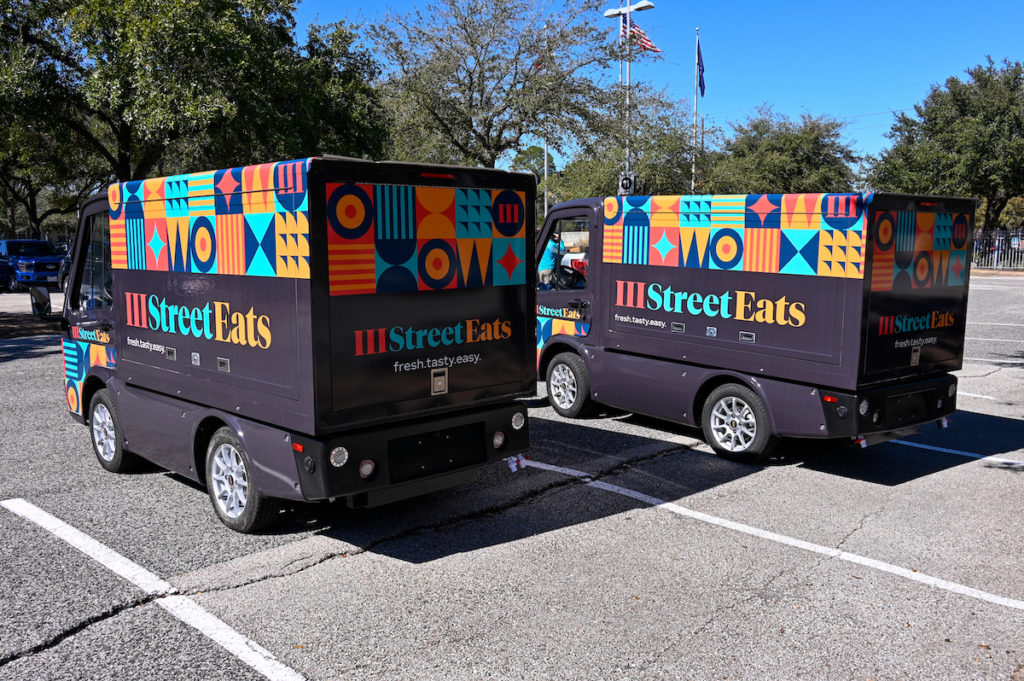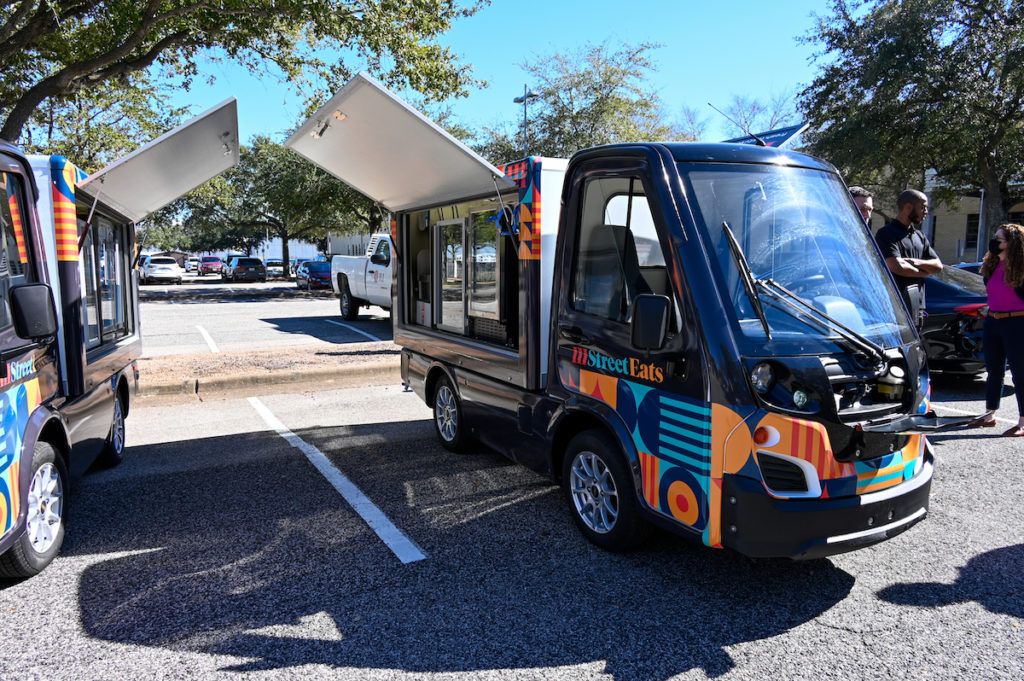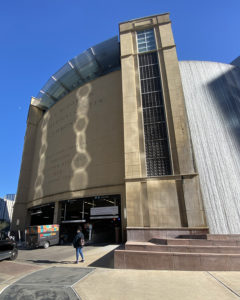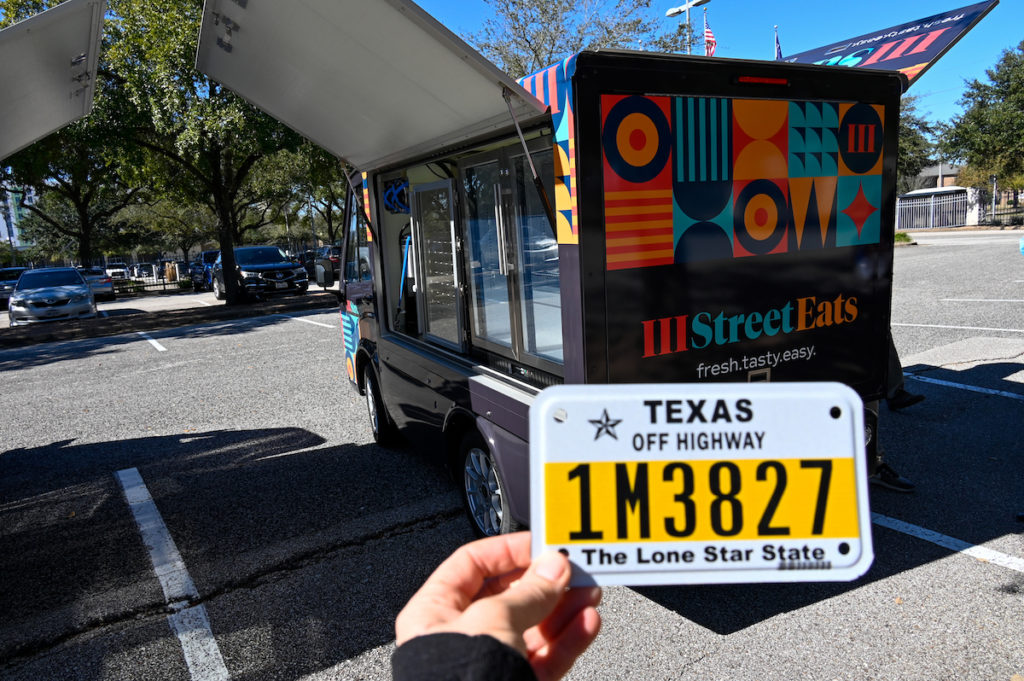
Erin Manning from Gallery Carts and Isaac Middleton from Texas Medical Center discuss the implementation of Electric Vehicles for food service on the TMC campus.
Erin: Thank you for taking time to meet today. Can you give me some background about yourself, how you started, and where this idea came from?

Isaac: Sure! I’m Isaac Middleton, and I am the Chief Operating Officer here at Texas Medical Center. I am on my second career; I was a military officer for 10 years in the Marine Corps. Then, after the Marine Corps, I came to Texas Medical Center as a strategy consultant.
My purview is all of our operating businesses. We have a parking business, a leasing business, a hospitality business, a handful of restaurants, and food courts. I work very closely with my counterpart Tatianna Yale, our Chief Investment and Planning Officer. She and her team, along with me and my team, are thinking about our strategic plan.
I think it’s important to mention that the Texas Medical Center is a nonprofit, so we get to be a business for purpose rather than just a business for business’ sake. It helps that everyone on the leadership team has a very, very strong business background, so we think about it as a business, but oftentimes the value we’re trying to create is not always money. It’s the experience of the doctors, nurses, orderlies, folks that come to work on our campus. It’s the experience of our patients that come to our campus. It’s in support of our mission which is to advance health research and education.
So with that in mind, as we go into our strategic plan, one of the common complaints is that it is a food desert. There’s a historical reason for that, and it’s probably too much information, but to create what the Texas Medical Center is now – which is 1400 acres of dense clinical and research buildings and with 60+ different member institutions – 75 years ago, we did that by acquiring the land and granting it for free, either by deed with restrictions or by land lease for like a dollar a year for hundred years. And what that did is that it enticed folks like MD Anderson Cancer Center, Houston Methodist, CHI, all the big players at Baylor College of Medicine to come here and create proximity and density. Those land restrictions prevent any kind of for-profit activity. Part of that is to protect nonprofit hospitals from for-profit hospitals.

An unintended consequence is that it also restricts industry, so translational research – and it also restricts retail. You can have food, but you can’t advertise it. So, if you walk through the Texas Medical Center, you’ll see… nothing! There are just no signs anywhere that say where the food is. If you go inside Houston Methodist Hospital, you’ll all of a sudden see an Einstein Bagels and a food court, but nobody knows it’s there because there’s this restriction on for-profit signage. We have some control over that, but in the near term, as we begin to rethink our green space and our amenities here on our dense clinical campus, we wanted to bridge the gap in the food deserts.
In parallel with that problem – that’s our clinical campus – we have a new campus coming up that is our translational research campus – it’s not even a mile away from here. It’s 37 acres we are redeveloping with five parks with gardens and it’s all focused on translational research, which is taking products from the research to the bedside – so, bench to bedside.
We’ve done a great job of getting very heavy-duty research done on this campus but not so great of a job at commercializing it and getting it out to the bedside. So, there’s a whole focus on that. And on that campus, we’ve changed the restrictions altogether. The whole ground plan of that campus is going to be open to the public and focused on retail and amenities and making sure the experience of folks on our campus is positive.
Now, what we didn’t want is to have this huge dichotomy. We have this new campus coming up that is super comfortable, beautiful, easy to interact with, and has all the amenities. Then we have the old campus that feels a bit closed off. So, as we transition this [the old] campus to be more open and improve the experience of folks that come to this campus, we wanted something where we could take food to them. Because that’s one of biggest complaints. People who can’t find lunch are not happy people. So, we opened up a restaurant over here called III By Wolfgang Puck.
Originally, we thought about bringing in food trucks from Houston, but then you start to lose control over where they go and lose a little bit of control of the traffic patterns and flow of the campus. So we said, we’re going to just do it ourselves! We wanted it to be small. We wanted it to be clean. And when I say clean, I mean environmentally-friendly. That’s important because if our whole mission is health, and we are not paying attention to the health of our environment around us, I think we’re missing something. So, our mobility plan for the campus is always looking towards cleaner and more environmentally-friendly.
We wanted something small to drive over to Garage Two, which is super busy at seven in the morning, pull up on the sidewalk, open up, and have coffee and breakfast for the folks sitting there waiting for the shuttle. We wanted it to be long-range enough to send it to the numerous construction sites that are up right now. We’ve got 600 construction workers at any given time on our new campus. We wanted to be able to serve each of those populations.

The second piece is it allows us to be flexible and identify the best positioning of hard structure retail. What I mean by that is as we start to develop on our main campus and think about restaurants that people can actually see and know where they are by sending the trucks around and monitoring the data, we’re going to understand where to build this. Where are the pinch points? Where are people actually collecting for lunch? And what’s the best place to grab them for dinner? We’re very excited! We’re just kicking it off, and I think everyone is surprised.
I actually just took my wife to see them before I came up here. She’s like, “Oh my God! These are way cooler than I thought they were going to be!”
That’s a very long-winded answer. I hope I have answered the question.
Erin: That was great! I was just looking at my list of questions here because there are so many things you touched on. There’s the environmental piece, what led to the decision to expand the mobile offerings… and I really like how you talked about how this can be a pilot program to see where people are gathering so that when you do build, it’s an R&D piece. You can be smart about where people are gathering to build restaurants as you move forward with expanding the campus.
Isaac: That’s right! We’re very data-driven, and this allows us to collect that data.
Erin: I think that’s brilliant, really.
Isaac: Another piece I think this is related to is on our new campus – it’s a series of parks like a helix chain. We anticipate the whole point of it being highly activated parks that are open to the public and our researchers working nearby. The retail is the ground plan of each of the buildings, but we anticipate large events, like graduations, maybe even weddings and concerts. At the intersections of the parks are cross streets, and food trucks like this allow us to be really nimble and scale-up for what’s happening in parks. We could pull these in, open them up, and if there’s an event – we have a liquor license for all the parks – we could pull up, open up and serve wine in the park. But then scale down for a Sunday afternoon when nothing’s going on. We just drive them away, and people can sit in the parks and have a good time. It gives us that bit of flexibility.
Erin: Well, and the other thing about this vehicle, because it has no emissions, you can actually drive it inside of a building.
Isaac: Yes. We did actually talk about that. In fact, we are in discussions with – maybe you’ve heard of them, The Boring Company. They bore tunnels underground for traffic. They are very fast, very efficient, and very affordable, relatively. Part of the reason is that you don’t have to provide the same level of ventilation because you only put electric vehicles through them. So, one of the thoughts in the medium to long-term is to connect our campuses with underground tunnels that electric vehicles travel through.
Erin: Now that’s really cool.
What led to the decision to expand the mobile offerings using the III by Wolfgang Puck kitchen?
I understand needing to have a place to prepare the food, so you’re utilizing a kitchen that’s already in existence, and it already has everything you need. Maybe you can go into that a bit?
Isaac: So, the restaurant here used to be Third Coast. It’s been here for a while, maybe 10-15 years. It’s an amenity to the Medical Center. There are not a lot of restaurants, and there are not a lot of reasonably nice restaurants where our doctors or executives can convene for a working lunch. So we wanted to transition it into a campus amenity because our campus needs it and our folks need it – but we wanted it to be a really good one where people actually want to come. So we partnered with Wolfgang Puck Catering in this respect to up the quality. It was good before, but to really take it a notch up.
And this is where it ties into the truck. We’re always thinking about infrastructure programs and services that we can provide for our member institutions and patients that come here, and one of those services that we could do more in is catering. So having Wolfgang Puck Catering on campus is helping us expand our catering and provide additional offerings via the restaurant. They don’t own the trucks, but they’re going to help us create a program to provide the food.
Erin: Okay. So you can utilize your kitchen to expand your offerings across multiple areas.
Isaac: Yes, expand across multiple areas. It also works as an advertising piece. This campus is big, and it’s dense, and there are people who come to work here probably for years and never enter this building. So you can use the fact that the food trucks will carry this high-quality, healthy food to areas where those folks are traversing and going about their day. We’ve now brought it down to their radar. So this exists, and it’s over here, and not it’s actually that far from you, and you might want to go check it out.
Erin: And it’s a really beautiful restaurant as well!
Isaac: Yes, it is. It’s great! I just had lunch there with my wife!
Erin: Nice! So the last question I have is about the relationship with Gallery Carts and how we work together, and anything that you find valuable or what we can work on?
Isaac: Yes, absolutely! I’ve been really impressed with our relationship with Gallery. I remember it was over a year ago, probably now, Philippe and I visited Denver, and I got to drive one of these little trucks around in the parking lot. I’m very hands-on, and I wanted to understand what we were getting into. And we had wonderful conversations. Despite all the complications of COVID, the Gallery team bent over backward to accommodate us, show us around the operation, explain the history of why you’re so good at fitting out these trucks from your history with kiosks and event support. So we were sold on the customer service very early, and then we got to get our hands on the product and really understand how it works.

It was exactly what we were looking for. I think we are sometimes a little bit difficult to work with, especially with the wraps, and the design and that sort of thing. Your team has been incredible, so I think that from a customer service point of view, it’s 10 out of 10! We looked at many different opportunities to bring food trucks to the campus, and no one else is quite doing it the way you are. It was exactly the right thing: the size, the footprint, the electric vehicle, that type of electric vehicle – it was just a really interesting offering.
The last piece was there was no point where we felt like we were being boxed into a particular product. It felt very customizable. It just so happened that one of the archetypes that you made was pretty damn close to what we wanted, but it did feel like if we pivoted, we could very easily refit the back of those trucks to something else.
I’m excited for us to launch and get the trucks out. Maybe we can circle back in a few months when we’ve got some data and interaction with vehicles and talk again. Would that be alright?
Erin: Yes! That would be great! Thank you for you time!